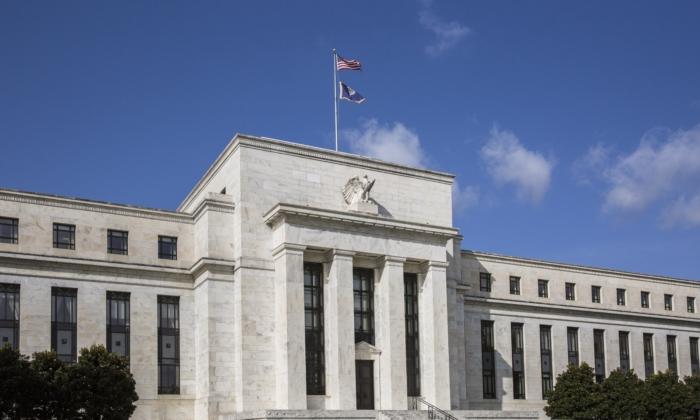A century ago, hyperinflation was reaching the explosion point in one nation while a deflationary boom was about to begin in another. The first event caused a national revolution that led the world into its worst nightmare of the century. The second led to another kind of nightmare, but one that helped defeat the first.
On Oct. 11, 1923, the German mark—which traded at four per U.S. dollar before 1914—fell to four billion per dollar in the postwar hyperinflationary period which destroyed the German currency by the end of November. Retirement savings evaporated, leading to social unrest and the Munich Beer Hall Putsch (a violent insurrection) led by Adolf Hitler and his National Socialist (Nazi) Party, with all the horrors that followed.
In America, by contrast, better times were just beginning as the Dow Jones Industrial Index bottomed out at 85.76 on Oct. 27, 1923, marking the effective start of the Roaring 20s bull market, which rocketed up 344 percent in less than six years, reaching Dow 381 on Sept. 3, 1929—and that was all a real gain (after inflation), as the 1920s were a mostly deflationary decade, in contrast to bull markets since then.
In the 1920s, America was under the discipline of the gold standard and a relatively enlightened financial management team under the direction of Secretary of the Treasury Andrew Mellon. In Europe, Germany could have avoided hyperinflation and returned to its prewar currency values if it were not for the punitive 1919 Treaty of Versailles, which demanded an unrealistic $33 billion in war reparations.
Young British economist John Maynard Keynes was in Versailles and counseled limited or zero war reparations, preferring debt forgiveness akin to the later Marshal Plan, but he was overruled. In his 1919 book, “The Economic Consequences of the Peace,” Mr. Keynes predicted a Second World War in 20 years!
In 1920, a shocked Germany did the rational thing—with a touch of vengeance: they printed marks in abundance to pay for losing the Great War they thought ended in stalemate. Even in 1920, there was little evidence of inflation, as the mark traded at 10 per dollar; little changed from its prewar 4-to-1 rate, but the mark fell to four billion per dollar by Nov. 1, 1923. The next week, a loaf of bread cost 140 billion marks. By Nov. 15, the mark was worthless and most German fortunes were destroyed.
In America, the Great Depression was not caused by the 1929 stock market crash. The market recovered strongly by the spring of 1930 but was sent into its death spiral by the Smoot-Hawley tariffs in June 1930 and by the Federal Reserve reducing money supply by approximately one-third, as documented by Milton Friedman and Anna Schwartz in their 1963 book, “Monetary History of the United States, 1867–1960.”
Future Federal Reserve boards learned from their mistakes and avoided deflation in the future, but Paul Volcker (who served as Fed chair from 1979–87) sailed close to the shoals of a deflationary shipwreck in 1980–82, after he had been tasked by then-President Jimmy Carter to break the back of inflation. He did so, with a vengeance, probably costing President Carter his job, but eventually breaking the back of inflation during Ronald Reagan’s presidency.
I’ve been reading my own newsletters of that era, AMEN (“Alexander’s Monthly Economic Newsletter”), and I was frankly terrified during the first half of 1982 that Chair Volcker was creating a new Great Depression with his draconian rate increases (to rates over 20 percent). I counseled investors to forget their inflationary strategies of the 1970s and treat “cash as king.” I didn’t break out of that funk until August, when Mr. Volcker suddenly cut rates in giant steps and the economy recovered in his massive game of financial “chicken.”
It’s unlikely that Jerome Powell or any future Federal Reserve chair will go as far as Paul Volcker did in attacking inflation, since the recent “transitory” inflation surge was not as seriously entrenched as the decade-long stagflation of the 1970s, which preceded Mr. Volcker’s blitzkrieg. In fact, this past July brought us deflation in goods sold by manufacturers (-4.1 percent year over year), wholesalers (-5.6 percent), and retailers (-0.3 percent), so the Fed has already achieved its desired 2 percent inflation target, except for the energy sector.
A century ago, the team of President Calvin Coolidge (1923–29) delivered prosperity, while the team of President Herbert Hoover (1929–33) did not. There are many technical reasons why, but President Coolidge said it best, “That man [Hoover] has offered me unsolicited advice for six years, all of it bad.” President Coolidge’s biographer, Amity Schlaes, followed up: “When Hoover’s orders emanated from the Commerce Department, they didn’t matter too much. Come to the presidency and the Depression, however, his policies did real damage.” Maybe we need to find “a new Cal” for 2024!







